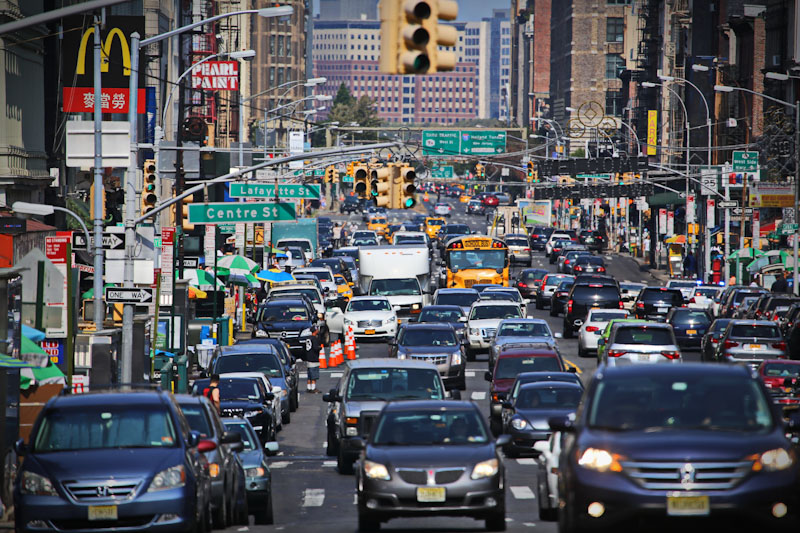MTA Sees Projects on the Chopping Block, Due to Gov’s Congestion Pricing ‘Pause’
By GEORGE DRAPEAU III – June 2024
NEW YORK—How will the MTA plug the day-to-day operating funds to offset the loss of $15 billion in bond funding, which the agency had planned to issue against an expected $1 billion in annual revenue from the congestion toll?
Gov. Hochul’s indefinite “pause” on the plan will now require the MTA to turn to other bonding sources that use the agency’s operating budget — specifically farebox revenue or money from the state’s payroll tax — as collateral.
The loss of capital money — meant to cover large expenses like capital projects, new train cars, safety equipment and facility repairs — is expected to drive the agency to borrow money against its day-to-day operating funds and force the agency to make the hard decisions on projects and equipment.

Last week MTA officials acknowledged that maintenance work will suffer without additional funding — but they’ve been reticent to say just how much repair and replacement work could need to be cut. “We’re probably not going to be able to do all the ‘state of-good-repair’ work,” MTA chairman Janno Lieber said earlier this month after Hochul put congestion pricing on pause on June 5. “We have to prioritize.”
First on the chopping block are expected to be the most expensive repair and replacement items — new subway rolling stock, according to published reports. The New York Daily News first reported last week that Gov. Hochul’s abrupt about face on congestion pricing has left the MTA scrambling to cover $28 billion in projects with only $13 billion to spend. “A massive 78% of that outstanding budget—nearly $22 billion—is for what the MTA calls ‘normal replacement’ or ‘state of good repair’ work—work agency brass says is necessary to keep the system safe and running,” the News reported.
The MTA announced in mid-June it had issued a stop-work order on the only contract yet awarded for Second Ave. subway’s phase two, a utility-relocation contract worth $182 million.
MTA Chairperson & CEO Janno Lieber has promised a “substantive” analysis for Wednesday’s board meeting on how the agency will “reprioritize and resequence and shrink” the largest capital program in agency history. The ambitious blueprint had largely focused on making dozens more stations accessible to people with disabilities, modernizing signals along multiple lines and buying more than 1,000 new subway cars. The next five-year capital plan is due in October.
That translates, in part, to the MTA putting initial work on Second Avenue Subway Phase II on ice — even as Hochul insists she is committed to funding the eventual extension of the Q line from 96th Street and Second Avenue to the Lexington Avenue line at 125th Street. It also imperils federal funding on many projects, while likely sidelining any work on the Interborough Express, the proposed Brooklyn-Queens light rail line that the governor has long touted, according to published reports.
In a report issued June 25, New York State Comptroller Tom DiNapoli said, “The MTA’s decisions in the coming weeks and months will affect riders for years to come. The MTA will be forced to put off badly needed investment in expansion and improvements to the system. Those choices will directly affect riders.”
He called for the MTA to provide an honest and transparent accounting of what it can afford and which capital projects it will prioritize and why. “The MTA’s decisions should ensure the basic maintenance of the system — safety, reliability and frequency — until it identifies realistic and sustainable replacement revenue,” he added.
DiNapoli’s report estimates there are over $21 billion in projects that potentially relied on congestion pricing revenue and are under review. The work to be reprioritized can be divided by their purpose:
- State of Good Repair: Line Structures, Depots and Yards. $1.78 billion.
- Normal Replacement: Railcars and Buses, $2.75 billion.
- System Improvements: Accessibility and Signal Modernization, $5.65 billion.
- Network Expansion: Second Avenue Subway (SAS), $5.23 billion.
- Administrative and Various: Communication, Power, Signal Modernization, $5.67 billion.
“We’re moving away from a major move toward handicap accessibility, away from [Phase II of] the Second Avenue Subway and new signaling,” said David Jones, a MTA board member. “Now we’re just making sure the wheels don’t fall off.”
Complied with combined news reports and press statements.
